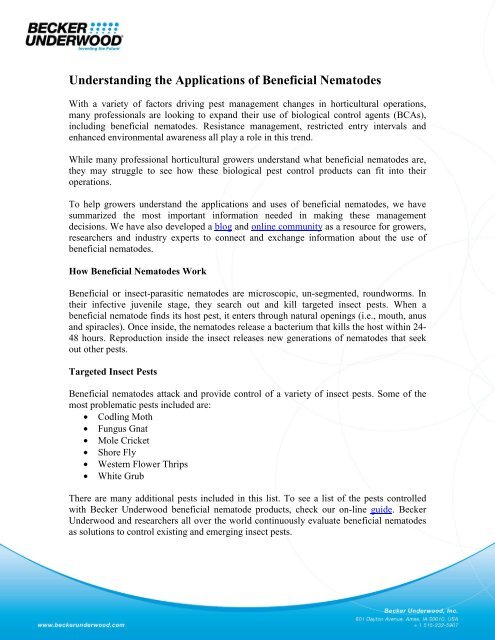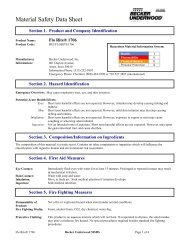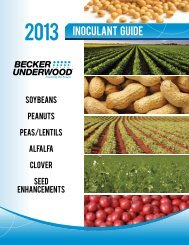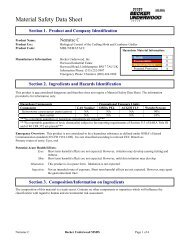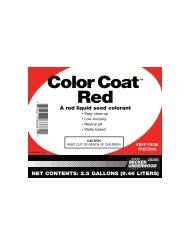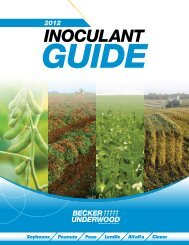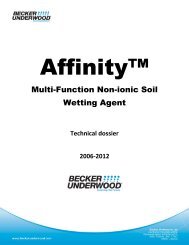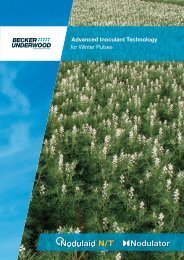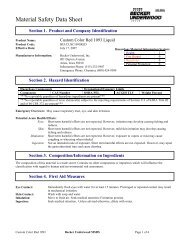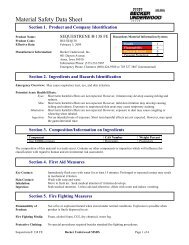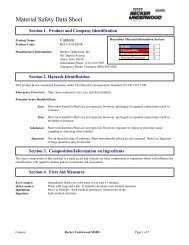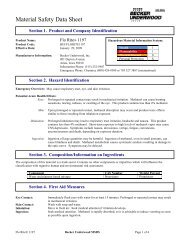beneficial nematode applications - Becker Underwood
beneficial nematode applications - Becker Underwood
beneficial nematode applications - Becker Underwood
Create successful ePaper yourself
Turn your PDF publications into a flip-book with our unique Google optimized e-Paper software.
Understanding the Applications of Beneficial Nematodes<br />
With a variety of factors driving pest management changes in horticultural operations,<br />
many professionals are looking to expand their use of biological control agents (BCAs),<br />
including <strong>beneficial</strong> <strong>nematode</strong>s. Resistance management, restricted entry intervals and<br />
enhanced environmental awareness all play a role in this trend.<br />
While many professional horticultural growers understand what <strong>beneficial</strong> <strong>nematode</strong>s are,<br />
they may struggle to see how these biological pest control products can fit into their<br />
operations.<br />
To help growers understand the <strong>applications</strong> and uses of <strong>beneficial</strong> <strong>nematode</strong>s, we have<br />
summarized the most important information needed in making these management<br />
decisions. We have also developed a blog and online community as a resource for growers,<br />
researchers and industry experts to connect and exchange information about the use of<br />
<strong>beneficial</strong> <strong>nematode</strong>s.<br />
How Beneficial Nematodes Work<br />
Beneficial or insect-parasitic <strong>nematode</strong>s are microscopic, un-segmented, roundworms. In<br />
their infective juvenile stage, they search out and kill targeted insect pests. When a<br />
<strong>beneficial</strong> <strong>nematode</strong> finds its host pest, it enters through natural openings (i.e., mouth, anus<br />
and spiracles). Once inside, the <strong>nematode</strong>s release a bacterium that kills the host within 24-<br />
48 hours. Reproduction inside the insect releases new generations of <strong>nematode</strong>s that seek<br />
out other pests.<br />
Targeted Insect Pests<br />
Beneficial <strong>nematode</strong>s attack and provide control of a variety of insect pests. Some of the<br />
most problematic pests included are:<br />
• Codling Moth<br />
• Fungus Gnat<br />
• Mole Cricket<br />
• Shore Fly<br />
• Western Flower Thrips<br />
• White Grub<br />
There are many additional pests included in this list. To see a list of the pests controlled<br />
with <strong>Becker</strong> <strong>Underwood</strong> <strong>beneficial</strong> <strong>nematode</strong> products, check our on-line guide. <strong>Becker</strong><br />
<strong>Underwood</strong> and researchers all over the world continuously evaluate <strong>beneficial</strong> <strong>nematode</strong>s<br />
as solutions to control existing and emerging insect pests.
How Can You Use Beneficial Nematodes<br />
Whether your interest in using <strong>beneficial</strong> <strong>nematode</strong>s is driven by a sustainability initiative<br />
or by chemical resistance issues you have experienced, there are a variety of ways to<br />
evaluate their place in your operation.<br />
Compatibility<br />
Nematodes can be used as a standalone program or in rotation with conventional<br />
insecticides to effectively control pest populations. Because insect parasitic <strong>nematode</strong>s have<br />
no adverse affects on <strong>beneficial</strong> insects or microorganisms, <strong>nematode</strong>s also can be used in<br />
conjunction with other BCAs to broaden the pest control spectrum. <strong>Becker</strong> <strong>Underwood</strong><br />
provides a compatibility chart so you know what products work in combination with our<br />
<strong>beneficial</strong> <strong>nematode</strong>s.<br />
Chemical Use<br />
Using BCAs to manage pest populations can reduce the number of insecticide <strong>applications</strong><br />
needed. Therefore, <strong>beneficial</strong> <strong>nematode</strong>s can be an extremely effective tool in your IPM<br />
program.<br />
Re-Entry Interval<br />
Beneficial <strong>nematode</strong> products have no re-entry interval. This means it is safe to enter the<br />
application area immediately following spraying of <strong>nematode</strong>s. If other pesticides or<br />
chemicals are included with the application, check their labels for REI information.<br />
Resistance Concerns<br />
There is no risk of insect pests developing a resistance to <strong>beneficial</strong> <strong>nematode</strong>s. Many<br />
species of insects can develop resistance to certain chemicals that have been applied<br />
frequently. That is not a concern with <strong>beneficial</strong> <strong>nematode</strong>s. They physically enter the body<br />
of the pest and release a bacterium that causes the death of the insect.<br />
Safety<br />
Beneficial <strong>nematode</strong>s are host-specific and only affect targeted insect pests. They are<br />
harmless to any organism – human, plant, animal – other than susceptible insects. Because<br />
<strong>beneficial</strong> <strong>nematode</strong>s are non-toxic and harmless to humans, there is no need for applicators<br />
to wear protective gear, and no disposal restrictions.<br />
Application Requirements<br />
Because <strong>beneficial</strong> <strong>nematode</strong>s are living organisms, they demand more specific<br />
environmental conditions.
Nematodes should be applied when temperatures are below 86ºF. Darker, cool, wet<br />
conditions maximize <strong>nematode</strong> activity, whereas hot, dry conditions may reduce<br />
effectiveness. Pulling blackout curtains, increasing humidity, tank-mixing with spray<br />
adjuvants and increasing the application volume are all ways to preserve moisture and<br />
prolong the life of <strong>nematode</strong>s on plants.<br />
Mixing <strong>nematode</strong> solutions is an important and often overlooked step in the application<br />
process. Nematodes will quickly settle out of a spray solutions which causes uneven<br />
<strong>nematode</strong> <strong>applications</strong> and ultimately, uneven pest control. <strong>Becker</strong> <strong>Underwood</strong><br />
recommends using a bubbler device, which is inexpensive to build and simple to use.<br />
Application equipment commonly used for conventional insecticides may be used to apply<br />
<strong>nematode</strong>s. Typically, a higher level of pest control can be achieved when regular, weekly<br />
<strong>applications</strong> are made.<br />
Beginning Your Program<br />
As you begin to incorporate <strong>beneficial</strong> <strong>nematode</strong>s into your pest control program, turn to<br />
<strong>Becker</strong> <strong>Underwood</strong>. We offer resources and extensive customer support to help you<br />
achieve the best results with products continually used and proven by professionals just like<br />
you.<br />
For more information about <strong>beneficial</strong> <strong>nematode</strong>s storage and <strong>applications</strong>, visit our<br />
website or contact <strong>Becker</strong> <strong>Underwood</strong> at 800-232-5907.


